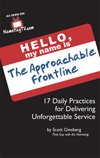
 Don’t get me wrong.
Don’t get me wrong.
It’s a fine idea to assume your people will engage if they know their work makes a difference to the organization.
But don’t fool yourself.
People don’t care about your organization as much as your organization thinks they do.
They care about themselves, their career, their bank account, their families and their future.
That’s why much of the existing material on engagement, while nice in principle, is myopic in practice.
It fails to address the issue of self-interest.
It refuses to stay sensitive to the needs of the human spirit.
It doesn’t focus on building people, rather, on building the organizational dream and exploiting people to do it.
As Scott Adams said it best a recent Dilbert cartoon: “We need more of what management calls ‘Employee Engagement.’ I don’t know the details, but it has something to do with you idiots working harder for the same pay.”
The reality is:
People engage when the fruits of their engagement become transportable assets.
People engage when they know they’ll become better in all areas of their life – not just beef up the bottom line.
People engage when their work isn’t a set of tasks, but an opportunity to build a platform that pushes them to something bigger.
People engage when they know that they can recoup their discretionary effort when they leave, as opposed to surrendering years of emotional labor to the organization.
Today we’re going explore a collection of practices to help you engage the people who matter most:
1. Making people feel important is overrated. If you truly want people to engage, you need to make them feel essential. That word derives from the Latin essentia, which means, “essence.”
That’s what being an approachable leader is all about: Honoring, loving and acknowledging the essence of another person. And showing them how quickly the place would fall apart without their contribution.
Sure, telling a person how cute her shoes look makes her feel nice; but telling her how inspiring her energy is makes her feel essential. Try this: Before you start bootlicking, ask yourself:
What attributes of her core self do I admire?
What facets of his personhood are most attractive?
What could I say to honor this person’s uniqueness?
Pay compliments that matter – not just flatter. And if concerned that your comment will “go to their head,” don’t worry – it won’t. It will go to their heart. It will remain there forever. And they will be more engaged than a Midwestern farm girl on graduation day.
Remember: The interpersonal impact of a compliment is directly proportionate to the level of thought required to deliver it. Do your words make people feel important or essential?
2. Make no restrictions on people’s testimony. Engaged organizations don’t need to spend millions on marketing – their people do it for them. They don’t need to sell the world on the quality of the springs; they just give others the chance to jump on the trampoline with them.
That’s what happens when people are fully engaged: They’re not just committed – they’re contagious. They’re living brochures of the organization’s awesomeness. And they voluntarily infect others with their experience in the hopes that those people will jump ship and join them.
Pastor Rob Bell wrote about this in his book, Velvet Elvis:
“I am far more interested in jumping than I am in arguing about whose trampoline is better. You rarely defend the things you love. You enjoy them and tell others about them and invite others to enjoy them with you.”
My suggestion is to put a system in place that removes the restriction of their expression. From blogs to message boards to meetup groups to online communities, the available tools – both online and offline – are endless.
The whole point is to give their river a voice, then give their voice a platform. And if you make it easy to spread the word, your most engaged people will make sure that everybody knows it. How are you letting your own people do your marketing for you?
3. Stop asking people to edit themselves. It’s one thing to edit a paper – it’s another to edit a person. Be very careful with this. Editing means correcting the core of something. And the moment you allow that to happen – to the work or to the person who authors it – is the moment of betrayal.
What’s more, editing renders creativity timid and impotent, and it’s not fair to people to let that happen.
My suggestion: Assure that people’s true identity is allowed to emerge. Enable regular expressions of eccentricity. And petition people to inject their personality into everything they do.
Otherwise their truth will feel jailed. And nothing disengages people quicker than interfering with the expression of their individuality. Ultimately, it’s about allowing them to walk their truth, breath their brand and stay loyal to themselves.
And while it’s probably safer to edit, for those who seek to turn their lives into remarkable portraits of brilliant creative expression, safe is a very dangerous place to be. Maybe it’s time to retire that big red pen you’ve been carrying around the office for five years. Whom are you asking to edit themselves?
4. Embed their passion into the pavement that leads the way. People engage when they’re consistently given the opportunity to do what they do best. When their work is united with their sense of life. And when what they do becomes a vehicle for living what is important to them.
The secret is to find out what’s under people’s fingernails. To identify the labor that stays with them wherever they go, becomes part of their language and merges with their very being.
This information is priceless. And it’s not something you create a field for in your customer database. It’s something you learn by listening to people’s hearts. It’s something yon learn by asking people passion finding questions like: “If you were the last human on Earth, what would you still do every day?”
The point is: Knowing what’s under people’s fingernails doesn’t just give you their hot button – it gives you their entire motherboard. Not to manipulate them – but to inspire them to motivate themselves. How quickly do you introduce passion into the engagement equation?
5. Help them develop a deeper sense of why. Knowing how is the path to education – but knowing why is the conduit to inspiration. If you want your people to be engaged every single day, you need to tap into (and reinforce) their why.
Otherwise, what the hell are they even doing there? Your mission is to help them see their work as more than just a job. Here’s how:
First, ask people to answer the question, “Why do you do what you do?” one hundred times. This exercise is hard, but it forces them to calculate their personal currency. (Don’t forget to have them send you a copy!)
Second: Invite them to plaster their workspace with tangible representations of the items on that list. This surrounds them with a monument to their why.
Finally: Encourage them to revisit both their list and their wall decorations any time the creeping feeling of disengagement enters their mindspace. In so doing, you’ll provide them with ongoing opportunities to inspire the hell out of themselves.
Remember: People want to live the dream – their dream. Are you helping them create a go-to space for self-motivation?
6. Accept that people aren’t bound to you. Peter Drucker famously suggested that all organizations treat their people as volunteers. This is a smart, strategic – and realistic approach. And it completely recolors the timbre of your encounters with people.
Volunteers, after all, do what they do because they want to – not because they need to. And if they don’t like the direction things are moving in, they’re gone. As I learned from Incentive Intelligence:
“Managing volunteers isn’t about directing effort as much as it is about allowing effort to find it’s best path. You have to ask yourself what you would do differently if all your staff could just walk out tomorrow.”
This is especially applicable to the top producers and high achiever of your organization. Think about it: Recruiters are probably hounding them on a daily basis. And if you haven’t confronted the fact that people are loaning their talents to you until something better comes along, you’re in for one hell of a wake up call.
Considering the culture and economic shifts to a more entrepreneurial marketplace – and the fact that the median time a person stays in one job is four years – you should be grateful they’ve people have given up their most valuable resource to become part of your organization.
Never rest on your engagement laurels. Golden handcuffs notwithstanding, most people they can leave anytime they want. In the words of Chris Rock, “People are only as loyal as their options.” What are you pretending not to know?
REMEMBER: Nobody shows up disengaged.
If they did, you never would have hired them in the first place.
People become disengaged over time.
Which means, at some point between the day they started – and the day you caught them taking a nap under their desk in the middle of the day – something broke.
Go fix it.
LET ME ASK YA THIS…
Why do you think people engage?
LET ME SUGGEST THIS…
For the list called, “46 Types of Marketing,” send an email to me, and I’ll send you the list for free!
* * * *
Scott Ginsberg
That Guy with the Nametag
Author, Speaker, Entrepreneur, Mentor
[email protected]
 Satisfaction not enough?
Satisfaction not enough?
Customers not telling their friends about you?
Want to learn how to deliver unforgettable service?
Buy Scott’s book and learn how to get your frontline in line!
Pick up your copy (or a case!) right here.
